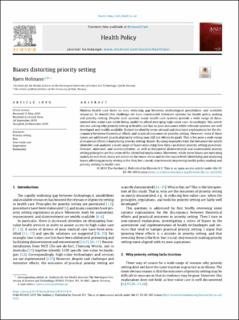Biases distorting priority setting
Peer reviewed, Journal article
Published version
Permanent lenke
https://hdl.handle.net/11250/2730617Utgivelsesdato
2020Metadata
Vis full innførselSamlinger
Sammendrag
Modern health care faces an ever widening gap between technological possibilities and available resources. To handle this challenge we have constructed elaborate systems for health policy making and priority setting. Despite such systems many health care systems provide a wide range of documented low-value care while being unable to afford emerging high-value care. Accordingly, this article sets out asking why priority setting in health care has so poor outcomes while relevant systems are well developed and readily available. It starts to identify some rational and structural explanations for the discrepancy between theoretical efforts and practical outcomes in priority setting. However, even if these issues are addressed, practical priority setting may still not obtain its goals. This is because a wide range of irrational effects is hampering priority setting: biases. By using examples from the literature the article identifies and analyses a wide range of biases indicating how they can distort priority setting processes. Overuse, underuse, and overinvestment, as well as hampered disinvestment and undermined priority setting principles are but some of the identified implications. Moreover, while some biases are operating mainly on one level, many are active on the micro, meso and on the macro level. Identifying and analyzing biases affecting priority setting is the first, but crucial, step towards improving health policy making and priority setting in health care.

